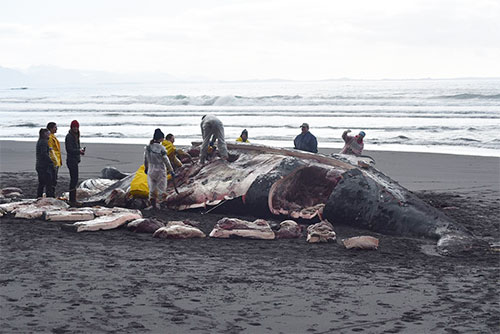
UAS stranding network team leads local volunteers for whale necropsy near Sitka
March 22, 2021
Dr. Lauren Wild, a professor with the Fisheries Technology department at the University of Alaska Southeast (UAS), is the local volunteer coordinator of the stranding network in Sitka, having recently taken over for Jan Straley, a whale biologist and professor at UAS Sitka who led the group for many decades. This means if a call comes in about a dead whale or pinniped around Sitka, the NOAA stranding folks in Juneau will get in touch with Dr. Wild and if there is an opportunity to respond, she will organize a group of local volunteers. If the animal is a pinniped or sea otter it is their policy to let the Sitka Tribe of Alaska know as well.
On Sunday, March 14th, the US Coast Guard spotted the dead humpback whale and called it in to the NOAA Fisheries Stranding network coordinator in Juneau. Dr. Ellen Chenoweth of UAS was able to get out that afternoon on a boat with a drone operator, Joshua Houston of Sitka, to collect imaging of the whale. The weather deteriorated by Monday the 15th and a necropsy team was organized for Thursday, March 18. The US Coast Guard volunteered to drop a group of six volunteers on the beach from air station Sitka, and four additional volunteers came out by boat to help as well. Lauren Wild led the volunteer group consisting of:
The group spent about five and a half hours on the beach on March 18th performing a necropsy, with a main goal to determine cause of death. The whale was cut open and the group looked for signs of trauma, that might include hemorrhaging or bone fractures. The whale was a 47-foot female, in good body condition with average blubber depth, and a full stomach that looked to be comprised of mainly fish remains. Tissue samples were collected from the lungs, heart, liver, stomach, and other organs and will be sent to the Alaska Veterinary Pathology Services and Dr. Kathy Burek for histology and pathology analysis. The findings for cause of death were inconclusive at the time, but tissue samples, data, and footage will be reviewed and analyzed, and a report will come out in the coming months that may help determine cause of death. Dr. Wild notes, “We did get some great images of the ventral, or underside of the flukes from the drone images on Sunday, but as of [March 18th] we have been unable to match the whale’s flukes to our database, but are still working on that. We will also note that this is a fairly unusual event; the last humpback whale that washed up in Sitka Sound was in 2016 I believe, so it was a unique opportunity to have a fairly freshly dead whale wash up in an area that was accessible, and we had a good weather window to get out there.” If people see a dead marine mammal, or a stranded animal that is still alive, they should call the NOAA Fisheries Alaska Marine Mammal Stranding Hotline: (877) 925-7773. UAS Sitka houses the stranding network equipment and provides supplies to volunteers. Learn more about fisheries technology programs, marine biology and other areas of study available at the University of Alaska Southeast at uas.alaska.edu/apply/programs or by speaking to an advisor at (907) 796-6000. UAS Sitka Acknowledgments:
Edited By Mary Kauffman, SitNews
Source of News:
|
||||
